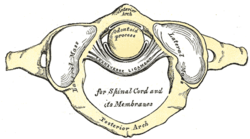Transverse ligament of atlas
| Transverse ligament of the atlas | |
|---|---|
 | |
 Membrana tectoria, transverse, and alar ligaments. (Transverse ligament visible at center.) | |
| Details | |
| Identifiers | |
| Latin | ligamentum transversum atlantis |
| TA98 | A03.2.04.006 |
| TA2 | 1703 |
| FMA | 24961 |
| Anatomical terminology | |
In anatomy, the transverse ligament of the atlas is a broad, tough ligament which arches across the ring of the atlas (first cervical vertebra) posterior to the dens[1] to keep the dens (odontoid process) in contact with the atlas.[citation needed] It forms the transverse component of the cruciform ligament of atlas.
Structure
[edit]The length of the ligament is variable; its mean length is 2 cm.[1]
The ligament broadens[1] and thickens[2] medially. The anterior medial aspect of the ligament is lined by a thin layer of articular cartilage.[1] The neck of the odontoid process is constricted where it is embraced posteriorly by the transverse ligament[2] so it retains the dens in position even after all other ligaments have been sectioned.[1]
Attachments
[edit]The ligament attaches on either side onto a small yet prominent tubercle upon the medial aspect of either lateral mass of atlas.[1]
Cruciate ligament
[edit]A strong median band (crus superius[2]) extends superiorly from the superior margin of the ligament to attach onto the basilar part of occipital bone (between the attachments of the apical ligament of dens, and tectorial membrane). A weaker and somewhat inconsistent median band (crus inferius[2]) extends inferiorly from the ligament to attach onto the posterior aspect of the[1] body of[2] axis. The ligament and the two median bands together constitute the cruciate ligament of atlas.[1]
Relations
[edit]The transverse ligament divides the vertebral foramen of the axis into an anterior portion (constituting one third of its lumen) which contains the dens, and a posterior portion (constituting two thirds of the foramen's lumen) which contains the spinal cord and its coverings[1] as well as the two accessory nerves (CN XI).[2]
Clinical significance
[edit]Excessive laxity of the posterior transverse ligament can lead to atlantoaxial instability, a common complication in patients with Down Syndrome and Ehlers–Danlos syndrome. Laxity has also been hypothesized as the cause of degenerative hypertrophy and mechanical atlantoaxial stress.[3] Degenerative processes can give rise to transverse ligament cysts, resulting in progressive cervical myelopathy. The treatment of choice for transverse ligament cysts with progressive neurological decline is surgical resection and cervical fusion.[4] Conservative treatment with external neck immobilization is less commonly reported , but may be very useful in select cases where immediate surgical intervention is not indicated.[5][6]
See also
[edit]References
[edit]- ^ a b c d e f g h i Standring, Susan (2020). Gray's Anatomy: The Anatomical Basis of Clinical Practice (42th ed.). New York. p. 841. ISBN 978-0-7020-7707-4. OCLC 1201341621.
{{cite book}}: CS1 maint: location missing publisher (link) - ^ a b c d e f Gray's anatomy, 1918
- ^ Takeuchi, Mikinobu; Yasuda, Muneyoshi; Takahashi, Emiko; Funai, Mikiko; Joko, Masahiro; Takayasu, Msakazu (December 2011). "A large retro-odontoid cystic mass caused by transverse ligament degeneration with atlantoaxial subluxation leading to granuloma formation and chronic recurrent microbleeding case report". The Spine Journal. 11 (12): 1152–1156. doi:10.1016/j.spinee.2011.11.007. ISSN 1878-1632. PMID 22177924.
- ^ Van Gompel, Jamie J.; Morris, Jonathan M.; Kasperbauer, Jan L.; Graner, Darlene E.; Krauss, William E. (April 2011). "Cystic deterioration of the C1-2 articulation: clinical implications and treatment outcomes". Journal of Neurosurgery. Spine. 14 (4): 437–443. doi:10.3171/2010.12.SPINE10302. ISSN 1547-5646. PMID 21314283.
- ^ Sagiuchi, Takao; Shimizu, Satoru; Tanaka, Ryusui; Tachibana, Shigekuni; Fujii, Kiyotaka (August 2006). "Regression of an atlantoaxial degenerative articular cyst associated with subluxation during conservative treatment. Case report and review of the literature". Journal of Neurosurgery. Spine. 5 (2): 161–164. doi:10.3171/spi.2006.5.2.161. ISSN 1547-5654. PMID 16925084.
- ^ Oushy, Soliman; Carlstrom, Lucas P.; Krauss, William E. (2018-03-05). "Spontaneous Regression of a Retroodontoid Transverse Ligament Cyst: A Case Report". Neurosurgery. 84 (2): E112–E115. doi:10.1093/neuros/nyy036. ISSN 1524-4040. PMID 29518219.
